INSTITUTIONAL STRATEGIES OF INNOVATION BASED SECTORAL SUSTAINABLE DEVELOPMENT (CASE OF ESTONIAN AGRICULTURE AND FISHERIES STRATEGY)
Abstract
Sustainable development has become a critical goal for institutions worldwide, necessitating comprehensive strategies that address the complex interplay between economic growth, environmental protection, and social equity. This research explores the institutional strategies for sustainable development, emphasizing the importance of a multi-dimensional approach to foster a more sustainable and equitable future. One of the primary strategies adopted by institutions is the integration of sustainability into their core policies and practices. This involves setting clear, measurable goals aligned with the principles of sustainable development. Institutions often develop sustainability frameworks that guide decision-making processes, ensuring that environmental, social, and economic considerations are balanced. The objective of research deals with the studying of case of development of institutional based strategy on example of Agriculture and Fisheries Strategy 2030 of Estonia. Estonian agriculture has undergone significant changes since the 1990s as a result of reforms, political and legislative changes. The need to develop a comprehensive national Strategy is due to the influence of a number of global trends in sectors related to agriculture, fishing and the food industry. These transformations are related to the dynamics of incomes, new technologies related to agriculture, the state of the environment, changes in consumer attitudes, trade liberalization, energy and urbanization. As a result, there is an increase in consumption of agricultural products and trade, intensification and concentration of production. The strategy is focused on using Estonia's existing competitive advantages related to its existing resource base and geographical location. Compared to other EU countries, Estonia is well endowed with biological resources, but the bottleneck is the low added value of exports of low-processed products. An important vector in the agro-bioeconomy is related to the recycling of waste and by-products, which is not popular in Estonia. For the implementation of relevant biotechnological solutions, it is necessary to coordinate research and development, as well as knowledge transfer.
References
Omelyanenko V. (2020). National strategic innovation security policy making (theoretical review). Tallinn. Teadmus.
Omelyanenko, V. (2017). Analysis of conceptual aspects of institutional and technological design. Technology Audit and Production Reserves, 2(5(40), 31–36. DOI: https://doi.org/10.15587/2312-8372.2018.128651
EU Commission (2023). At a glance: ESTONIA’S CAP STRATEGIC PLAN. Available at: https://rural-interfaces.eu/wp-content/uploads/2020/04/csp-at-a-glance-estonia_en.pdf
Pub Affairs Bruxelles (2022). Common Agricultural Policy 2023-27: strategic plans for Estonia and Latvia worth €3.8 billion approved. Available at: https://www.pubaffairsbruxelles.eu/eu-institution-news/common-agricultural-policy-2023-27-strategic-plans-for-estonia-and-latvia-worth-e3-8-billion-approved/
Directorate-General for Agriculture and Rural Development (2022). The Commission approves the CAP Strategic Plans of Estonia and Latvia. Available at: https://agriculture.ec.europa.eu/news/commission-approves-cap-strategic-plans-estonia-and-latvia-2022-11-11_en
Directorate-General for Agriculture and Rural Development (2024). Estonia – CAP Strategic Plan. Available at: https://agriculture.ec.europa.eu/cap-my-country/cap-strategic-plans/estonia_en
Estonian Land Board (2015). Ajalooliste Kaartide Rakendus.
European Commission (2020). Financial needs in the agriculture and agri-food sectors in Estonia. Available at: https://www.fi-compass.eu/sites/default/files/2020-07/financial_needs_agriculture_agrifood_sectors_Estonia_executive_summary.pdf
Eurostat (2019). Agriculture, forestry and fishery statistics: 2019 edition, Publications Office of the European Union, Luxembourg. DOI: https://doi.org/10.2785/743056
Gonzalez-Corzo, M. A. (2013). Estonia's Post-Soviet Agricultural Reforms: Lessons for Cuba al Reforms: Lessons for Cuba. CUNY Academic Works. Available at: https://academicworks.cuny.edu/cgi/viewcontent.cgi?article=1085&context=le_pubs
Gruère, G., Shigemitsu, M. & Crawford, S. (2020). Agriculture and water policy changes: Stocktaking and alignment with OECD and G20 recommendations. OECD Food, Agriculture and Fisheries Papers, No. 144, OECD Publishing, Paris. DOI: http://dx.doi.org/10.1787/f35e64af-en
Jörgensen, H. (2005). Subsistence farming in re-independent Estonia: expanded private plots! Acta Historica Tallinnensia, (9), pp. 69–94. DOI: https://doi.org/10.3176/hist.2005.1.03
Jürgenson, E. (2016). Land reform, land fragmentation and perspectives for future land consolidation in Estonia. Land Use Policy, Vol. 57, pp. 34–43.
Ministry of Regional Affairs and Agriculture (2023). Agriculture and Fisheries Strategy 2030. Available at: https://www.agri.ee/en/ministry-news-and-contact/ministry-regional-affairs-and-agriculture/agriculture-and-fisheries#:~:text=The%20Estonian%20Agriculture%20and%20Fisheries,conditions%2C%20food%20safety%2C%20sustainable%20rural
Ministry of Regional Affairs and Agriculture (2023). Agriculture and Fisheries Strategy 2030. Available at: https://www.agri.ee/sites/default/files/documents/2021-09/poka-2030-executive-summary-2021.pdf
OECD (2018a). Innovation, Agricultural Productivity and Sustainability in Estonia. DOI: https://doi.org/10.1787/9789264288744-en
OECD (2018b). The Estonian agricultural innovation system. in Innovation, Agricultural Productivity and Sustainability in Estonia, OECD Publishing, Paris. DOI: https://doi.org/10.1787/9789264288744-10-en
OECD (2019). Agriculture and water policies: main characteristics and evolution from 2009 to 2019. Estonia. Available at: https://www.oecd.org/agriculture/topics/water-and-agriculture/documents/oecd-water-policies-country-note-estonia.pdf
Rasva, M., & Jürgenson, E. (2022). Agricultural Land Concentration in Estonia and Its Containment Possibilities. Land, 11, 2270. DOI: https://doi.org/10.3390/land11122270
Unwin, T. (1997). Agricultural restructuring and integrated rural development in Estonia. Journal of Rural Studies, Vol. 13, Iss. 1, pp. 93–112.
WorldBank Natural Resources Management Division (1997). Estonia Agricultural and Forestry Policy Update. EC4NR Agriculture Policy Note #10. Available at: https://documents1.worldbank.org/curated/en/289171538244565173/pdf/Estonia-agricultural-and-forestry-policy-update.pdf
